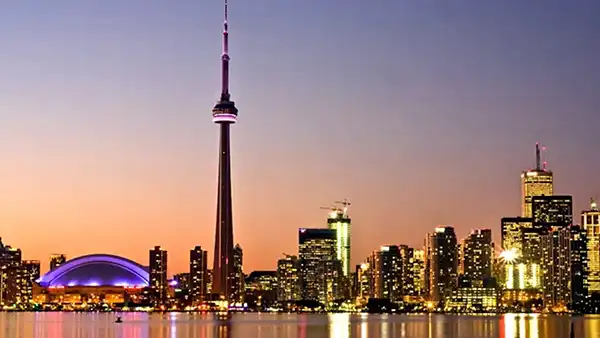Toronto: A Mosaic of Heritage, Innovation, and Urban Wilderness
Perched on the northern shores of Lake Ontario, Toronto is Canada’s cultural and economic heartbeat—a city where skyscrapers pierce the clouds above Victorian neighborhoods, where global cuisines mingle in bustling markets, and where art and nature thrive in unexpected corners. As one of the world’s most multicultural cities, with over 130 languages spoken, Toronto invites travelers to explore its layered identity, from Indigenous roots to futuristic creativity.
Historical Tapestry: From Indigenous Lands to Modern Metropolis
Toronto’s history stretches back over 11,000 years, when Indigenous communities like the Wendat and Haudenosaunee first inhabited the region. The city’s name derives from the Mohawk word tkaronto, meaning “where there are trees standing in the water,” referencing the wooden stakes used for fishing weirs in Lake Simcoe. This deep Indigenous legacy is honored at the Royal Ontario Museum (ROM), which houses artifacts from the Wendat, Anishinaabe, and Métis peoples.
The 19th century transformed Toronto into a British colonial hub, evident in landmarks like the Distillery Historic District, a red-brick Victorian-era whiskey production site now repurposed into galleries, theaters, and artisan shops. Meanwhile, the St. Lawrence Market, established in 1803, remains a living testament to Toronto’s mercantile past. Voted the world’s best food market by National Geographic, its stalls overflow with Ontario cheeses, fresh seafood, and maple syrup, while butchers demonstrate century-old techniques.
No visit is complete without ascending the CN Tower, a 553-meter engineering marvel. Completed in 1976, it once held the title of the world’s tallest free-standing structure. Visitors can brave the glass-floored observation deck, dine in the 360° rotating restaurant, or—for adrenaline junkies—walk the EdgeWalk along its outer rim.
Modern Art and Cultural Renaissance
Toronto’s art scene pulses with rebellious energy. The Museum of Contemporary Art (MOCA), housed in a converted 1919 auto-parts factory, challenges conventions with video installations and interactive exhibits. During its opening weekend, artists often engage visitors directly, while the adjacent brewery offers craft beer tastings. For a grassroots experience, Queen Street West dazzles with street art, indie galleries like Magic Pony, and avant-garde boutiques such as Teatro Verde.
Each May, the Doors Open Toronto festival unlocks access to architectural gems like the Franklin Carmichael Art Centre, a log-cabin gallery in Etobicoke, and Gibraltar Point Centre for the Arts, a repurposed schoolhouse on the Toronto Islands. These events highlight the city’s playful side, blending history with contemporary design.
Nature’s Embrace: Urban Oases and Lakeside Trails
Despite its urban sprawl, Toronto prioritizes green spaces. The Rattray Marsh Conservation Area in Mississauga offers a serene escape just 30 minutes from downtown. Its 1.1-kilometer waterfront boardwalk winds through wetlands teeming with herons and painted turtles, while shale beaches invite quiet reflection. Closer to the core, the Toronto Islands provide car-free bliss: rent a bike to explore secluded beaches, kayak lagoons, or picnic under the shadow of the Gibraltar Point Lighthouse, Canada’s oldest surviving lighthouse.
For hikers, the Glen Major Forest near Stouffville boasts 48 kilometers of trails through oak ridges and coniferous forests, part of the ecologically critical Oak Ridges Moraine. Within the city, High Park blooms with cherry blossoms each spring and features a free zoo, while the Humber River Recreation Trail offers riverside cycling amid autumn foliage.
Culinary Crossroads: Global Flavors on a Plate
Toronto’s food scene mirrors its diversity. In Kensington Market, a bohemian enclave, savor Jamaican patties at Golden Patty or vegan tacos at Hibiscus Café. The nearby Greektown on the Danforth serves up succulent souvlaki, while Little India near Gerrard Street East tempts with butter chicken and gulab jamun.
For budget-friendly eats, Aristos Souvlaki & Gyros on Queen Street West delivers hearty pork gyros stuffed with fries and house-made tzatziki for under $10—a favorite among students and office workers. Upscale options abound too: Alo Restaurant, ranked among Canada’s best, offers a French-inspired tasting menu, while Lake Inez in the East End fuses Filipino and Nordic flavors in dishes like sinigang-braised pork belly.
Retail Therapy: From Underground Malls to Vintage Treasures
Toronto’s shopping landscape caters to all tastes. The PATH Underground City, a 30-kilometer network beneath the Financial District, connects 1,200 shops, perfect for winter escapes. Above ground, Yorkville dazzles with luxury boutiques like Chanel and Hermès, while Queen Street West lures fashion rebels with vintage stores like Black Market and Public Butter.
For local flair, St. Lawrence Market’s weekend antique fairs and Kensington Market’s thrift shops offer unique finds. Asian shoppers flock to Pacific Mall in Markham, North America’s largest Asian indoor mall, where bubble tea stalls and K-pop merch abound.
Cultural Festivals and Inclusive Spirit
Toronto’s calendar brims with celebrations. June’s Pride Parade draws millions to Church Street, while October’s TIFF (Toronto International Film Festival) transforms the city into a cinephile’s paradise. In winter, the Toronto Christmas Market at the Distillery District enchants with twinkling lights and mulled wine.
The city’s inclusivity shines in details like wheelchair-accessible trails and multilingual signage. Even its parks encourage interaction: lawns often bear signs saying “Walk on the Grass,” inviting visitors to connect with nature.
Practical Tips for Travelers
- Transport: The TTC subway and streetcars efficiently connect major attractions. Consider a Presto Card for seamless travel.
- Timing: Visit May–September for festivals and outdoor activities, or December for holiday markets.

- Accommodation: The Drake Hotel in Queen West doubles as an art hub, while the Fairmont Royal York offers historic luxury.
Toronto defies easy categorization—it’s a city where a morning hike through ancient forests can lead to an afternoon of gallery-hopping, followed by a sunset gyro by the lake. Here, every neighborhood tells a story, and every meal is a journey. Whether you’re tracing Indigenous heritage at the ROM or dancing at an underground indie concert, Toronto promises not just a visit, but an evolution.